April 20, 2007
Prototypes of Moving Pictures
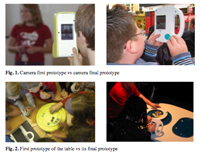
A Spontaneous + Collaborative Approach to Video Creation
The full paper written for Interact 2007 with http://web.media.mit.edu/~ishii/ is accepted! It shows how Textable Movie designed for facilitating video production has informed Moving Pictures. It presents a mechanism to seamlessly interface the various parts in video production and present our observations. The conference topic is socially-responsible interaction. So see you in Rio de Janeiro in September!
Abstract: The paper presents a novel approach to collecting, editing and performing visual and sound clips in real time. The cumbersome process of capturing and editing becomes fluid in the improvisation of a story, and accessible as a way to create a final movie. It is shown how a graphical interface created for video production informs the design of a tangible environment that provides a spontaneous and collaborative approach to video creation, selection and sequencing. Iterative design process, participatory design sessions and workshop observations with 10-12 year old users from Sweden and Ireland are discussed. The limitations of interfacing video capture, editing and publication in a self-contained platform are addressed. Download the 14 pages paper. [blogged by Cati Vaucelle on Architectradure]
Posted by jo at 05:19 PM | Comments (0)
September 02, 2005
FALLING LIFE
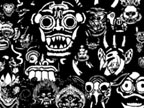
Crashing Ars
Falling Life is an ongoing project that was introduced for the first time in Berlin in August 2005. This urban screening project doesn’t need a curator or a gallery; it doesn’t need a fixed place or access to electric power. The artists are equipped with a car, a laptop, a compact light powerful projector and a small power generator. With this very mobile equipment the artists are able to have an instant presence in the urban landscape. They use facades of buildings that can be immediately changed into a projection screens. What makes the project exciting is the variety of possible buildings as a projection surface: the more uneven and in relief they are the more magic they look. Without any preparation and without any permits the artists are operating in a kind of projection guerrilla style.
Michael Bielicky and Kamila B. Richter are using a minimalist language of white constantly appearing and disappearing pictograms. The moving icons represent the collective reality of our interconnected globalized world. With the help of an algorithm the combination, amount, size and speed of the objects is permanently changing and so the image is never the same. The artists don’t reduce only the form of the displayed objects but also the color absence results in a pure white light. It is fascinating that the whole movie with a 25 different sequences can have a size of 250KB!!!
The next public appearance of Michael Bielicky’s and Kamila B. Richter’s light projections will be in September at the Ars Electronica festival in Linz. The (not invited) artists will apply the theme of this year festival - “Hybrid – living in paradox” on the Ars Electronica itself: Ars Electronica is living in paradox. The artists use the same hybrid strategies Ars Electronica aims to discuss as they create their own hybrid Ars Electronica layout by copying and recombining some of the language and pictorial units used for this year Ars Electronica’s promotion material. Michael Bielicky and Kamila B.Richter: x[at]avu.cz. Also see Locomotion.
Posted by jo at 10:52 AM | Comments (0)
August 27, 2005
Obsession
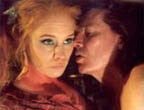
Manuscape: An Instrument for Non-Linear Storytelling
"I have just got back from Helsinki where I saw Pia Tikka's interactive film Obsession at Kiasma Art Museum. This is a four screen work of immense complexity, working with an automated rules-based system of clip selection, influenced by an audience's physiological reactions to what is seen on screen. Swivelling chairs allow the programme to compile data on viewers's gaze direction, while an interactive handprint on the chair arm picks up subtle alterations in skin conductivity and pulse rate and augments the presentation of image according to arousal states. The subject of the film is sexual obsession and attitudes to rape-conflating female desires and fantasies with a semi-documentary narrative. This is an innovative work, using aspects of audience mobility and biology to alter content." [blogged by Martin Rieser on Mobile Audience]
Obsession (2003-), Finland
Project URL: http://crucible.uiah.fi/crunet.nsf/etofilmpages/obsessio
Actor: Media Lab / University of Art and Design
People: Pia Tikka, Rasmus Vuori
Genre: interactive film/ installation and research project
Obsession is an interactive film/ installation and research project by film director Pia Tikka which uses motion sensors, cinematic metadata and generative algorithms. The participant has control over the drama flow in a manner that respects the affective nature of the cinematic media, where the participant may even lose conscious control over the flow of the events. Both conscious actions and unconscious sensorimotor reactions of the participant‘s mind/body can have effect on the narrative. Analyzed images are assigned a position in the narrative story-world map, i.e. the manuscape. The manuscape works as an instrument for non-linear storytelling and allows development of a range of interactive multimedia applications. Interaction and software design by Rasmus Vuori.
From the project web site:
Obsession is an attempt to describe, how the traumatic acts of violence not only affect the individual, but how his or her family and the life-environment are also violated. The narrative level of Obsession, in regard to its subject matter of "sex and violence" in our representational culture, brings this important subject matter to the focus of discussion. Inside the four walls of a self-service launderette, young Emmi and an entrant stranger, Henrik, measure embodied distance. From their interaction, a loaded emotional situation emerges, framed by a trauma that Emmi and Emmi’s mother Jatta share. The distorted mind of Emmi creates an endlessly wandering path of narrative potentialities and interpretations.
The computational core of Obsession is a narrative engine, based on content metadata. Inspired by the Russian film theorist Sergei Eisenstein (1898-1948), the”montage-machine” of Obsession maps spectators’ psycho-physiological states to cinematic elements. Obsession is a kind of enactive cinema: How the narrative unfolds, and how rhythm and soundscape are formed, depend on how the spectator lives by the emotional dynamics between the characters.
Posted by jo at 01:03 PM | Comments (0)
May 30, 2005
ResonanCITY
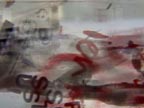
Live Audiovisual Performance
Many sounds and images in our everyday lives slip past our notice simply because they are too small, or because we lack the proper receivers to pick them up. ResonanCITY is an ongoing project to gather these microscopic sounds from various cities, and to amplify and transform them. The goal is to build a new city of sound and visuals inside the old one, and to inspire curiosity and exploration of one's own environment. Video artist Sara Kolster, searches for details and objects which she transformed in a microscopic way into macro-images. She uses different macro-lenses and a lightbox, capturing and manipulating these images live, without the use of any filters. The combination of film- and video techniques with analogue tools as found footage, positive film and photographs gives the performance a layered character.
The sound of resonanCITY is based on gathering elements which are specific to each location and reinterpreting them in a performance setting. Field recordings, found objects, folk music and spoken texts are mixed and processed live with the computer with the intention of uncovering hidden details and nuances that escape everyday perception. For some performances, the audience is encouraged to bring objects which they think might become interesting if listened to more carefully, and an improvisation is based on these objects. Quicktime movie.
Posted by jo at 12:29 PM | Comments (0)
February 09, 2005
Cyburbia Productions

Live Movies
Cyburbia Productions, a multimedia performance studio, focuses on the collaborative creation of "live movies," syntheses of cinema, theater and music. The company’s work employs digital projection and sound technologies, and filmic narrative techniques, to construct moving stage pictures and sonic theater, in which live actors interact with animated performers, and emerge from or vanish into projected environments, settings and dreamscapes.
Projects include: SILENCE & DARKNESS is a live movie for the cell phone age by Kirby Malone, and passages from Jean Baudrillard, Guy Debord, and Heiner Müller. See list of productions here.
Posted by jo at 11:54 AM | Comments (0)
January 19, 2005
Interactive Panoramic Cinema

Embodied Spectatorship
Paper abstract: For most of the past 100 years, cinema has been the premier medium for defining and expressing relations to the visible world. However, cinematic spectacles delivered in darkened theaters are predicated on a denial of both the body and the physical surroundings of the spectators who are watching it. To overcome these deficiencies, filmmakers have historically turned to narrative, seducing audiences with compelling stories and providing realistic characters with whom to identify. This paper describes several research projects in interactive panoramic cinema that attempt to sidestep the narrative preoccupations of conventional cinema and instead are based on notions of space, movement and embodied spectatorship rather than just storytelling. Example projects include interactive works developed with the use of a unique 360 degree camera and editing system, and also development of panoramic imagery for a large projection environment with 14 screens on 3 adjacent walls in a 5-4-5 configuration with observations and findings from an experiment projecting panoramic video on 12 of the 14, in a 4-4-4 270 degree configuration. [via USC Interactive Media Division]
Title: "Experiments in Interactive Panoramic Cinema"
Location: USC Zemeckis Center, Room 201
Time: 6:00pm-8pm, 1/19/2005
Steve Anderson, Susana Ruiz, and Scott Fisher will give a summary of the work done over the past year with Sony's Fourth View panoramic video camera system. This will be a runthrough of a paper to be given by Steve tomorrow in the annual SPIE conference in San Jose on "The Engineering Reality of Virtual Reality 2005" chaired by Mark Bolas.
Posted by jo at 05:43 PM | Comments (0)
December 27, 2004
netzwissenschaft
![]()
Emerging Infrastructures of All (Inter)net Research
Dr. Reinhold Grether's network research | netzwissenschaft site maps the "emerging infrastructures of all (inter)net research endeavours. net.science as an anthropology of connectivity is trying to overcome the constraints of specialist method transfers on net matters. the protuberance of technical networks necessitates a professionalization of human net knowledge. neither the isolation of concepts as in basic research nor the encapsulation of processes as in applied sciences will ever be able to adequately describe the complex autopoiesis of networks. net.science is undoubtedly developing into a scienza nuova of its own right."
Check out his Mobile Art and Virtual Performance research areas.
Posted by jo at 04:45 PM | Comments (0)
November 19, 2004
not yet it's difficult
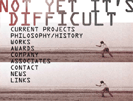
BLOWBACK
not yet it's difficult has a unique presence in Australia's contemporary performing arts culture as a research unit, a producer of industry development programs and a contemporary events maker.
Established in 1995, not yet it's difficult is an ideas-based group of artists who collaborate on the production of public performance events and cross-media projects under the artistic direction of david pledger. not yet it's difficult has produced original theatrical works through its Performance Series, public space projects, play productions, video-installation, new media, television, and, in association with other performance companies, workshop, forum, research and development programs. not yet it's difficult's philosophy is to make work cumulatively and collaboratively. Development practice links research and performance to presentation and analysis. not yet it's difficult's mission is to make critically engaged artworks of high artistic and discursive quality.
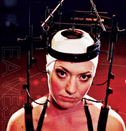
Current projects include: Eavesdrop, 2004, interactive cinema. David Pledger, Artistic Director of not yet it’s difficult and Jeffrey Shaw, world-renowned pioneer of interactive cinema, push the cinematic and the theatrical imaginary in this extraordinary new work. Part game, part real-time film-making, part spectator sport, part magical realism, Eavesdrop opens up the user and the viewer to new ways of looking at old forms, progressive pathways to interactivity and an alternative mode of visual discourse.
Blowback, 2004, theatre: BLOWBACK is an inter-disciplinary theatrical work crossing film, text and dance. Coined by America’s intelligence services, the term blowback describes the situation in which an agent of American foreign policy retracts their support. Using the body and video as double agents, BLOWBACK will be a kind of gestural, agit-prop, horror movie, part science fiction, part documentary, part absurdist metaphor. BLOWBACK will premiere at Memorial Hall, rear St Kilda Army & Navy Club, 88 Acland Street, St.Kilda, Melbourne on 27 November and 4 December 2004 (Previews November 25 and 26).
Posted by jo at 05:10 PM | Comments (0)
September 30, 2004
Interactive Cinema

A Real-time Editing Engine for an Algorithmic Sitcom
Office Voodoo is an interactive film installation for two people. It tells the story of Frank and Nancy, two bored Irish officemates, condemned to spend their lives in an office. This infinite film is an algorithmic sitcom inspired from Sartre's play "Huis clos", crossbred with an office life simulator. Two physical voodoo dolls, that represent the protagonists, can be manipulated in order to change the emotions of the characters in the film. It is a social laboratory where the viewers can experiment on the influence of emotions as initial conditions in any social interaction. As viewers get skilled manipulating the dolls, they can control the emotions of Frank and Nancy, and see what happens when : Frank is cranky and Nancy is hyperactive ? Frank is horny and Nancy is depressed ?
The interactive film is made exclusively of real lens-based footage shot with real actors, but it runs on a real-time editing engine that fluidly assembles the film shot by shot as one watches it, while respecting the conventions of continuity editing. The installation is built as a little immersive wooden house for two people - a cross between a confessional, an arcade game booth and a kinetoscope parlour. Download PDF.
Posted by jo at 09:24 AM | Comments (0)
September 24, 2004
unsorted, SonicActsX

Live Cinema
This year Sonic Acts presents a special Live Cinema programme, in association with www.live-cinema.org.
"Live Cinema is a form of performance art in which a human performer manipulates sound and image in synergy through movement, for an audience. In the rapidly advancing field of Live Cinema there are a number of distinct movements, e.g. abstract synthetic cinema, graphic cinema and camera-based cinema. We will present a number of renowned performers from these areas in the small hall in Paradiso in a three-evening packed programme. The performances will be interspersed with interviews with the artists, and with a film and video programme specially compiled for Live Cinema organised in association with Martijn van Boven. A Sonic Acts Live Cinema special will be broadcast on television during VPRO’s Nachtpodium on Wednesday 22 September."
From the introduction to unsorted, SonicActsX: "An important traditional paradigm is the familiar distinction between art disciplines such as visual arts, music, dance, theatre and literature. Usually, the different works of information art are forced to fit within this classical categorisation model. This, however, provides us with a misleading image of the nature of the new arts. For instance, imagine two works of computer art, generated using largely similar algorithms. The first work has an aural output, the second results in visual forms. Then the first one will be labelled as music while the second will be called visual art. This might seem to be an arbitrary problem, but it becomes relevant when we realise that the infrastructures of, in this case, the musical world and the visual arts world operate in rather separated areas (art education, exhibition and performance spaces, criticism and analysis). Many of the interesting issues of (and between) artworks like these are being missed because they are positioned outside the current categorisation models." Read more.
"So what exactly is Live Cinema? Live Cinema springs from new presentation forms, arising as a direct consequence of the advancing digitalisation of visual and sound technologies. The synthesis between sound and image is something a few artists already are putting to practice. While other artists hold ambitions in that direction, a platform/lab gathering know-how and the creative potential digital technologies are inscribed with, is still lacking. The technological backdrop of Live Cinema is one of daily technological innovation in the audio-visual field. The process of digitalisation is most developed in the realm of electronic (pop)culture, where equipment is compact, user-friendly and affordable. All these factors have led to a new artistic practice, where the usage of hardware, such as samplers and computers, have led to new artistic genres and ways to approach art.
It is for these new art forms that I seek fitting formats of presentation, whether theatrical, cinematic, interactive, or on DVD. Live Cinema is all about the "live" event, where artists collaborate and work towards a performance where different artistic disciplines are more than the sum of their parts. Fixed components are music (not soundtrack) and image projection (not traditional film). The eventual result is a unique art experience for the spectator. Each time, just as in theatre or at a concert, it is different." Hans Beekmans
Posted by jo at 03:25 PM | Comments (0)
August 20, 2004
help me make it through the night
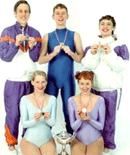
Acting Out
help me make it through the night, brought to you by the Gob Squad...
"In the blue, dead hours of night, four people return to their hotel rooms. None of them can sleep, instead they kill time in cold baths or by finding comfort in the solace of the hotel mini bar. Each is being watched by a surveillance camera, sharing their moments of fear and boredom as they sit out a long and sleepless night. In the conference room of the hotel the audience watches the four performers on a fourway split screen projection. In the anonymity and discretion of the hotel environment the performers will enact forbidden games and unlived desires at the request of the audience."
Posted by jo at 02:00 AM | Comments (0)
